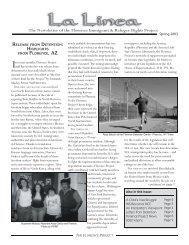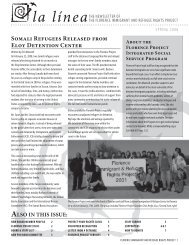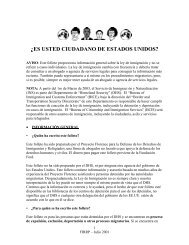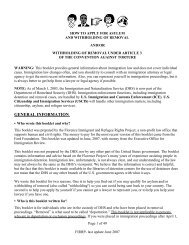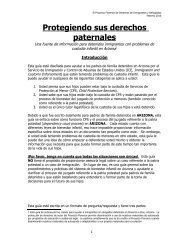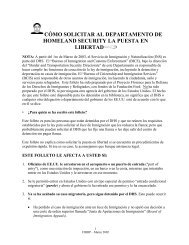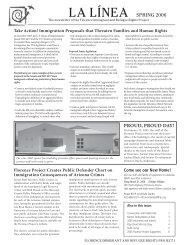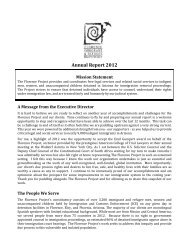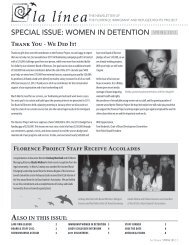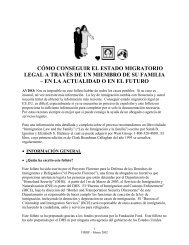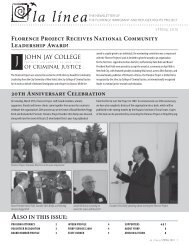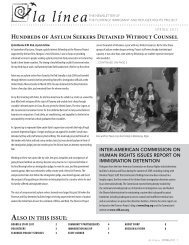quick reference chart and annotations for determining immigration ...
quick reference chart and annotations for determining immigration ...
quick reference chart and annotations for determining immigration ...
You also want an ePaper? Increase the reach of your titles
YUMPU automatically turns print PDFs into web optimized ePapers that Google loves.
Immigrant Legal Resource Center, Florence Immigrant <strong>and</strong> Refugee Rights Project,<br />
Maricopa County Public Defender August 2012<br />
Crime Involving Moral Turpitude (CMT): Yes, but with some possible exceptions. There is<br />
an argument that A2 is not a CIMT under Carr v. INS, 86 F.3d 949 (9th Cir. 1996), but most unpublished<br />
BIA decisions have held to the contrary. Simple assault knowing that the person was a police officer<br />
under A8 should not be a CMT, particularly when the plea involved mere offensive touching or the<br />
possibility of it under §13-1203(A)(3). The same might be true <strong>for</strong> other occupations listed in A8.<br />
Aggravated Felony: Crime of Violence. An intentional aggravated assault with a sentence<br />
imposed of one year or more will be considered a crime of violence. However, an aggravated assault with<br />
a mens rea of recklessness (as under § 13-1203(A)(1)) or the use of de minimus <strong>for</strong>ce (under (A)(3)) may<br />
not be a crime of violence, even with a sentence of one year or more. See Fern<strong>and</strong>ez-Ruiz v. Gonzales,<br />
466 F.3d 1121 (9th Cir. 2006) (en banc); Ortega-Mendez v. Gonzales, 450 F.3d 1010 (9th Cir. 2006).<br />
Immigration law uses the federal definition of a “crime of violence” found at 18 U.S.C. § 16.<br />
Section 16(a) of 18 U.S.C. requires the “use, attempted use, or threatened use of physical <strong>for</strong>ce,” while<br />
section 16(b) requires that the offense be a felony <strong>and</strong> involve a “substantial risk” that physical <strong>for</strong>ce may<br />
be used. In Fern<strong>and</strong>ez-Ruiz v. Gonzales, 466 F.3d 1121 (9th Cir. 2006) (en banc), the Ninth Circuit<br />
found that a conviction <strong>for</strong> misdemeanor assault under § 13-1203 did not categorically constitute a crime<br />
of violence under 18 U.S.C. § 16(a) since recklessness under (A)(1) would not involve the “use,<br />
attempted use, or threatened use of physical <strong>for</strong>ce.” However, the court did not reach the issue of whether<br />
a felony assault under § 13-1204 committed with a mens rea of recklessness would meet the definition of<br />
a crime of violence under section 16(b) by presenting a “substantial risk” that physical <strong>for</strong>ce may be used.<br />
But the Ninth Circuit has recently suggested that a Cali<strong>for</strong>nia “general intent” crime that employs a mens<br />
rea of recklessness would not be a “crime of violence” under section 16(b). See Flores-Lopez v. Holder,<br />
685 F.3d 857 (9th Cir. 2012).<br />
Defense counsel should conservatively assume that a conviction <strong>for</strong> aggravated assault with a<br />
sentence of one year or more will be held to be an aggravated felony. However, if a sentence of 364 days<br />
or less is not possible, counsel should attempt to specify a subsection that is more likely to involve a mens<br />
rea of recklessness, such as A1, A2, A6, A7, or A8. Since A3, A4, A5, A9, A10 are more likely by<br />
nature to involve the intentional use of <strong>for</strong>ce, these subsections should be avoided. Furthermore, a plea to<br />
the underlying definition of assault at § 13-1203(A)(1) or (A)(3), <strong>and</strong> use of the specific word<br />
“recklessness” in the plea agreement, will aid <strong>immigration</strong> counsel in arguing that the offense is not a<br />
crime of violence.<br />
Note that a plea to attempted assault will always involve an intentional mens rea <strong>and</strong> thus<br />
preclude the benefits of a plea to recklessness. United States v. Gomez-Hern<strong>and</strong>ez, 680 F.3d 1171, 1176<br />
(9th Cir. 2012) (“it is well-settled that attempted aggravated assault under Arizona law covers only<br />
intentional conduct”) (citing State v. Kiles, 175 Ariz. 358, 857 P.2d 1212, 1224 (1993) (“[A]ttempt is a<br />
specific intent crime <strong>and</strong> by definition involves intentional conduct.”). There<strong>for</strong>e, in order to avoid a<br />
crime of violence or a crime of domestic violence, counsel would be better off pleading to a straight<br />
assault than an attempt in order to leave open the possibility of a reckless mens rea.<br />
Other Grounds: Domestic Violence. See discussion of §13-1203.<br />
Other Grounds: Child Abuse: A6 (person is eighteen years of age or older <strong>and</strong> commits the<br />
assault on a child who is fifteen years of age or under) will likely be charged as a crime of child abuse<br />
under 8 U.S.C. § 1227(a)(2)(E)(i). See Matter of Soram, 25 I&N Dec. 378 (BIA 2010) (unreasonably<br />
placing a child in a situation that poses a threat of injury to the child’s life or health is categorically a<br />
Arizona Criminal Chart with Explanatory Endnote – August 2012<br />
26



